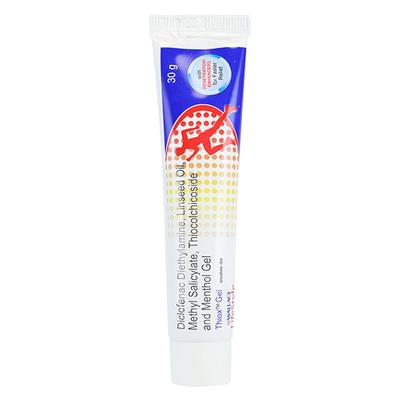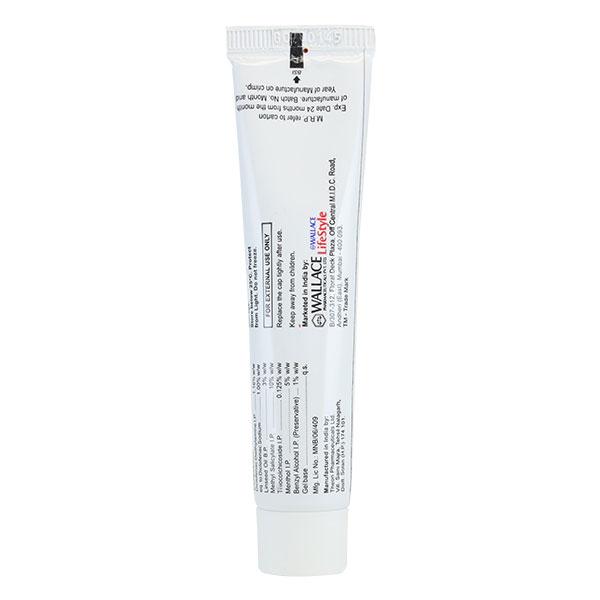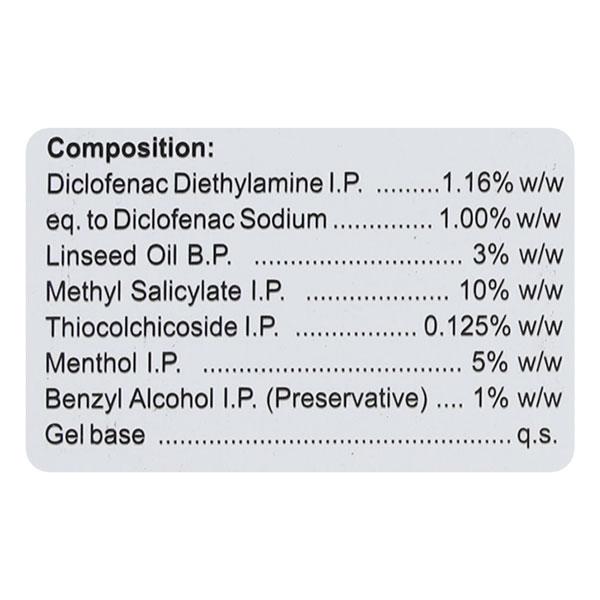

Netmeds First Membership
Quick Links
Introduction About THIOX GEL
THIOX GEL is a combination of Diclofenac, Linseed Oil, Menthol, Methyl Salicylate, and Thiocolchicoside which belongs to the group of medicines called Non-steroidal Anti-inflammatory Drug (NSAID), Cooling agents and Muscle Relaxant respectively. It is used to relieve muscle pain and spasms. It provides fast and lasting relief from back pain, osteoarthritis pain, rheumatologic disorders, and related conditions. This medicine is non-greasy and non-staining formulation, which gets absorbed quickly and has fast pain-relieving action.
Avoid exposure to the sun after using THIOX GEL. Consult your doctor for advice. THIOX GEL is not recommended for use in patients who have kidney diseases, had asthma, flaccid paralysis (sagging of face), muscular hypotonia (weak muscles), urticaria (allergic reaction) after use of NSAIDs such as aspirin, setting of coronary artery bypass graft surgery, or broken or irritated skin.
THIOX GEL is not recommended for use among women who are pregnant and breastfeeding. THIOX GEL is not recommended to use in children and adolescents below 15 years of age and children having flu, chickenpox, or fever. Caution must be exercised while using THIOX GEL in elderly patients. The most common side effects of using THIOX GEL are skin irritation, redness of the skin, rashes, dermatitis, burning or stinging sensation at the site of application. Consult your doctor’s advice if any of these doesn’t improve or worsen.
Uses Of THIOX GEL
It is used to relieve:
- muscle pain and spasms
- back pain
- osteoarthritis pain, rheumatologic disorders and related conditions
How THIOX GEL Works
THIOX GEL helps in relieving muscle pains and spasms whereas Diclofenac is an NSAID that causes relief in pain and inflammation by inhibiting the factors that cause inflammation and pain called prostaglandins. Linseed oil helps in minimizing skin irritation, soothes and calms the skin. Methyl salicylate acts by dilating the blood vessels and increasing blood flow. It causes irritation of the skin and because of counter-irritation, there is a sensation of warmth and relief in musculoskeletal pain. Menthol acts by acting as an irritant and imparts coolness to the skin and then warmth. Thiocolchicoside works through selective binding to the GABA-A receptor (neurotransmitter) which manages muscle contractions by activating the GABA inhibitory motor pathway and inhibiting the glycine receptors (neurotransmitters). Thus, relaxing the muscle pain and spasms.
How to use THIOX GEL
Apply THIOX GEL as advised by your physician. It is for external use only. Gently rub THIOX GEL on the affected area till it disappears. Your doctor will prescribe the right dose depends on your age, body weight and severity of the infection.
Side Effects Of THIOX GEL
Common
- skin irritation
- redness of the skin
- rashes, dermatitis, burning or stinging sensation at the site of application
Warning & Precautions
Pregnancy
Consult your doctorThere are no well-controlled studies of THIOX GEL in pregnant women. Consult your doctor before using it.
Breastfeeding
Consult your doctorIt is not known whether THIOX GEL is excreted in human milk. Consult your doctor before using it.
Alcohol
Consult your doctorIntake of alcoholic beverages while using THIOX GEL may increase the risk of stomach bleeding. So, limit the consumption of alcohol. Consult your doctor before using.
Kidney
ContraindicatedTHIOX GEL is not recommended for use in patients having advanced renal diseases. Consult your doctor before using.
Allergy
ContraindicatedDo not use THIOX GEL if you are allergic to Diclofenac, Linseed Oil, Menthol, Methyl Salicylate, Thiocolchicoside or any other ingredients of this medicine.
Lungs
ContraindicatedTHIOX GEL is not recommended for use in patients who have or had an asthmatic attack. Consult your doctor before using.
Heart Disease
ContraindicatedTHIOX GEL is not recommended for use in patients having heart diseases such as the setting of coronary artery bypass graft surgery. Consult your doctor before using.
Use In Pediatrics
ContraindicatedTHIOX GEL is contraindicated in infants below 2 years of age. Consult your doctor before using.
Use In Geriatrics
Use with CautionIn elderly patients, THIOX GEL should be used with caution. Your doctor will decide the correct dose and duration of the management with THIOX GEL depending on your age, disease condition and body weight. Consult your doctor before using.
Others
THIOX GEL is not recommended for use if you have:
- flaccid paralysis (sagging of face)
- muscular hypotonia (weak muscles)
Interactions
A. Drug-Drug Interactions:
Before using THIOX GEL inform your doctor if you are taking any of the following medicines:
- aspirin, ibuprofen (used to manage pain and inflammation), cyclo-oxygenase-2 (COX2) inhibitors such as celebrex, bextra (used to manage osteoarthritis or rheumatoid arthritis)
- spironolactone, furosemide (used to manage excess fluid in the body)
- cyclosporine, tacrolimus (used to supress immune system such as after transplants)
- lithium, citalopram, sertraline (used to manage anxiety and depression)
- digoxin, amiodarone (medicine used in managing an irregular heartbeat or heart failure)
- ramipril, azilsartan (used to lower down the blood pressure)
- warfarin (used as blood-thinning agents that reduces blood clotting)
- metformin, sitagliptin (used to control blood sugar)
- prednisolone (used as anti-inflammatory medicines)
- magnesium sulphate (used to manage heartburn, indigestion)
- chloramphenicol, ciprofloxacin, moxifloxacin (used to manage some infections)
- ketoconazole, fluconazole, miconazole, voriconazole (used to manage fungal infections)
- sulfinpyrazone (used to manage gout)
- mifepristone (used to terminate pregnancy)
- metoclopramide, domperidone (used for nausea)
- cholestyramine (used to manage high cholesterol or high blood fats)
- imatinib, methotrexate (used to manage cancer)
Overdosage:
In case of accidental ingestion or too much application of THIOX GEL, consult your doctor immediately or visit the nearby hospital.
Synopsis
| Drug | : | Diclofenac, Linseed Oil, Menthol, Methyl Salicylate,Thiocolchicoside |
| Pharmacological Category | : | Analgesics, Cooling agents, Muscle relaxants |
| Therapeutic Indication | : | Muscle pains and Spasms |
| Dosage Forms | : | Gel, Cream |
More Information
- Keep THIOX GEL out of reach of children
- Store below 30°C
FAQs About THIOX GEL
Q: Can THIOX GEL be used in pregnant and breastfeeding women?
A: There are no well-controlled studies of THIOX GEL in pregnant and breastfeeding women. Consult your doctor before using it.
Q: Does THIOX GEL cause skin irritation?
A: Yes, THIOX GEL may cause skin irritation. THIOX GEL contains Methyl Salicylate which acts by dilating the blood vessels and increasing blood flow. It causes irritation of the skin and because of counter-irritation, there is a sensation of warmth and relief in musculoskeletal pain.
Q: Is THIOX GEL safe for use in children?
A: THIOX GEL is contraindicated in infants below 2 years of age. Consult your doctor before using.
Q: In which condition THIOX GEL should not be used?
A: THIOX GEL is not recommended for use in patients who have kidney diseases, had asthma, flaccid paralysis (sagging of face), muscular hypotonia (weak muscles), urticaria (allergic reaction), coronary artery bypass graft surgery, or broken or irritated skin. Consult your doctor before using.
Q: Can I take alcohol while using THIOX GEL?
A: Intake of alcoholic beverages while using THIOX GEL may increase the risk of stomach bleeding. So, limit the consumption of alcohol. Consult your doctor before using.
References
1. K.D. Tripathi. NSAIDs and Antipyretic Analgesics, Drugs Acting on Skin and Mucous Membranes. Essentials of medical pharmacology. Seventh edition. 2013. Page – 204, 888 & 889.
2. NIH National Library of Medicine. National center for biotechnology information. Pubchem. Diclofenac Sodium. [Accessed on 16th August 2022] https://pubchem.ncbi.nlm.nih.gov/compound/Diclofenac
3. NIH National Library of Medicine. National center for biotechnology information. Pubchem. Methyl Salicylate. [Accessed on 16th August 2022] https://pubchem.ncbi.nlm.nih.gov/compound/Methyl-salicylate
4. J V Pergolizzi Jr, R Taylor Jr, J-A LeQuang, R B Raffa, NEMA Research Group. The role and mechanism of action of menthol in topical analgesic products. NIH National Library of Medicine, National center for biotechnology information. Pubmed.gov. June 2018. [Accessed on 16th August 2022] https://pubmed.ncbi.nlm.nih.gov/29524352/#:~:text=Results%3A%20Menthol%20is%20a%20selective,nociceptors%20and%20then%20desensitizing%20them.
5. Gaurav Kaithwas, Dipak K. Majumdar. Effect of L. usitatissimum (Flaxseed/Linseed) Fixed Oil against Distinct Phases of Inflammation. International Scholarly Research Notices. Feb 2013. [Accessed on 16th August 2022] https://www.hindawi.com/journals/isrn/2013/735158/
6. Cipla Ltd. Omni Gel. Ciplamed. [Revised in February 2020] [Accessed on 16th August 2022] https://www.ciplamed.com/content/omni-gel
7. Iasis Pharma Hellas. Thiocolchicoside. [Revised in February 2013] [Accessed on 16th August 2022] https://iasispharma.com/wp-content/uploads/pdf/RELIEF_gel_PIL_ENG.pdf
8. Leeford Healthcare Limited. Thioford Plus gel. [Accessed on 16th August 2022] https://www.leeford.in/product/1299/thioford-plus
9. Sanify Healthcare Private Limited. Nifoxide – Plus gel. [Accessed on 16th August 2022] https://www.sanifyhealthcare.com/product/diclofenac-diethylamine-ip-1-16-w-w-wq-to-diclofenac-sodium-1-00-w-w-thiocolchicoside-ip-0-125-w-w-linseed-oil-bp-3-00-w-w-methyl-salicylate-ip-10-00-w-w-menthol-ip-5-00-w-w-benzyl-alchol-ip-1-00-w-w/
10. Invision Medi Sciences Pvt. Ltd. Thionex DF gel. [Accessed on 16th August 2022] http://www.invisionmedi.com/category/thionexdf-gel.htm










